Abstract
Pilicides block pili formation by binding to pilus chaperones and blocking their function in the chaperone/usher pathway in E. coli. Various C-2 substituents were introduced on the pilicide scaffold by design and synthetic method developments. Experimental evaluation showed that proper substitution of this position affected the biological activity of the compound. Aryl substituents resulted in pilicides with significantly increased potencies as measured in pili-dependent biofilm and hemagglutination assays. The structural basis of the PapD chaperone-pilicide interactions was determined by X ray crystallography.
Introduction
The increasing bacterial resistance to many antibiotics has resulted in a growing interest in new antibacterial agents with new modes of action directed towards Gram-negative bacteria.1 Contrary to broad-range bactericidal or bacteriostatic antibiotics, drugs that specifically target bacterial virulence factors would exert less selective pressure on bacteria and minimize the risk for horizontal spread of drug-resistance genes.2-4 It is estimated that approximately 11 million cases of urinary tract infection (UTI) occur in the U.S. each year, primarily in women. Treatment of UTI, like other microbial infections, is exacerbated by increasing antimicrobial resistance. This has been described as an impending “public health crisis”. In addition, over 900,000 women and men in the U.S. experience three or more UTI episodes per year. Thus, antibiotics do not stop recurrence in this population, independent of antibiotic resistance, highlighting the need for alternative therapeutics.
Many Gram-negative bacteria, such as uropathogenic E. coli (UPEC), produce long filamentous structures called pili/fimbriae assembled by the chaperone/usher pathway (CUP pili)5, 6 that mediate colonization and invasion of host tissues.4, 7, 8 Compounds that target CUP pili have the potential to block virulence in a broad range of bacterial strains. The chaperones that are required for pilus assembly bind to pilus subunits and facilitate their folding by a mechanism termed donor strand complementation.9-11 Chaperone-subunit complexes are targeted to the outer membrane usher, which catalyzes pilus assembly by a process known as donor strand exchange.5, 12, 13 The chaperone is comprised of two immunoglobulin-like domains arranged in a boomerang shape. The usher has a 24 stranded beta barrel that forms a channel across the outer membrane. The channel is gated by a plug domain. Ushers also have two periplasmic domains. The N terminal periplasmic domain interacts, in part, with a hydrophobic patch on the N terminal domain of the chaperone exposed on incoming chaperone/subunit complexes. One class of compounds termed pilicides, consisting of a dihydrothiazolo ring-fused 2-pyridone scaffold, has been shown to prevent the formation of pili by blocking the interaction of chaperone/subunit complexes with the N terminal domain of the usher, thus preventing the donor strand exchange reaction and the formation of chaperone-usher assembled pili, exemplified in UPEC.14, 15 The X-ray crystal structure of pilicide 1 bound to the P pilus chaperone PapD revealed that compound 1 binds to the hydrophobic patch on the N terminal domain of the chaperone – formed by residues I93, L32, and V56 – which forms the well-conserved usher binding site (Figure 1).14, 16 Competition binding studies confirmed that the pilicide 1 prevents binding of chaperone-subunit complexes to the usher N-terminal domain. Pilicide 1, therefore functions, by blocking delivery of subunits to the usher thus preventing donor strand exchange and inhibiting pilus assembly (Figure 1). Besides being useful as potential antibacterial agents, pilicides have been used as chemical tools to study details of pilus assembly and their role in disease processes. 14, 17
Figure 1.
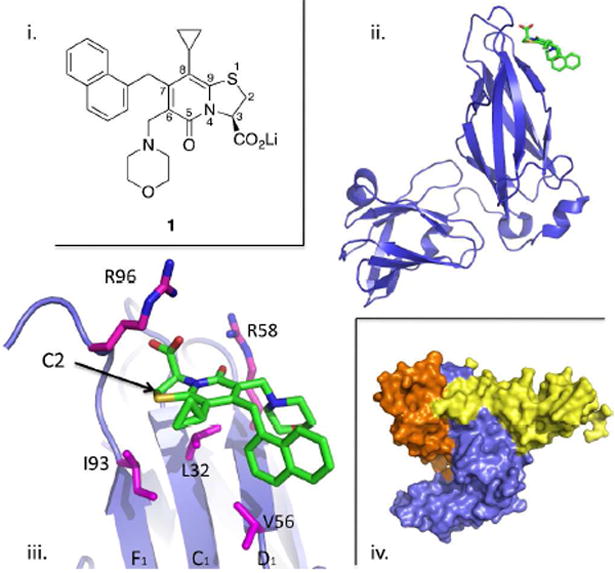
(i) Structure of pilicide 1. (ii) The pilicide 1 (green) binds to the N-terminal domain of the chaperone PapD (blue). (iii) The pilicide (green) occupies a hydrophobic patch formed by I93, L32, and V56 (purple). (iv) Through this interaction the pilicide occupies the usher N-terminal binding site on the chaperone-subunit complex and thus pauses pilus assembly (chaperone in blue, subunit in orange, usher N-terminal domain in yellow).
In the crystal structure showing pilicide 1 bound to the chaperone-subunit complex there is unoccupied space near the thiazolo-part of the pilicide scaffold (Figure 1, iii). We hypothesized that introducing substituents in this part of the scaffold could thus lead to favourable interactions between the chaperone and the pilicide and thereby result in increased biological activity. We decided to decorate the C-2 position on the scaffold to create interactions with the unoccupied space in the crystal structure in an attempt to improve pilicide activity. The dihydrothiazolo ring-fused 2-pyridone scaffold (4), that constitutes the platform for design of new pilicides, can be synthesized via an acylketene-imin cyclo-condensation. 18, 19 This method introduces substituents directly in the C-7 and C-8 position on the scaffold leaving position C-6 and C-2 open for further improvements of the pilicides (Figure 2). Previous studies have also described a number of methods for the introduction of various substituents in position C-6 on the core structure.20-22 Although this did not lead to any substantially increased biological activity, substitutions at C-6 allow for the introduction of solubility enhancing substituents. The C-2 position on the scaffold had not been varied until recently, when we reported on the decoration of this position starting from the α,β-unsaturated methyl ester (6) (Figure 2).23 From this α,β-unsaturated methyl ester substituents were introduced by conjugate additions resulting in an addition with complete trans selectivity. In addition, substituents were introduced with a retained double bond by the use of Heck couplings or deprotonation using Lithium diisopropylamide (LDA) and subsequently reacted the lithiated scaffold with different electrophilic reagents. Together, these different methods opened up the possibility to introduce a wide range of substituents with varying size, electronic properties and spatial arrangement (Figure 2).
Figure 2.

Synthesis of the dihydrothiazolo ring-fused 2-pyridone scaffold (4) from Δ2-thiazolines (2) and Meldrums acid derivatives (3). Prior to biological evaluation all compounds are hydrolysed (e.g. 4a to 5a). From the oxidized scaffold (6), methods to introduce substituents in position C-2 on the scaffold have been developed.
Here, we present biological and crystallographic data on second generation compounds that were synthesized via C-2 substitution of the thiazolo ring-fused 2-pyridone 6, based on the pilicide 1 – PapD complex crystal structure. The C-6 morpholinomethyl substituent in pilicide 1, earlier introduced for solubility reasons, was not included in this study as it is not vital for pilicide activity. The activities of the compounds were evaluated in pilus dependent biofilm and hemagglutination assays. Compared to the parent pilicide 5a, C-2 substituted compounds have significantly improved IC50’s in inhibiting pilus formation. The molecular basis of the observed improved biological activity of the compounds was determined by elucidating the X-ray crystal structure of pilicides bound to the PapD-PapH chaperone-subunit complex (PapH is the P pilus termination subunit24). The pilicides bound to the previously identified binding site on the chaperone N-terminal domain near strands F1, C1 and D1. The introduced substituents were accommodated in a shallow hydrophobic pocket on the chaperone surface, formed by residues P30, L32, I93 and P95.
Results and discussion
The developed methods for C-2 substitution were implemented to introduce a diverse set of substituents on a known pilicide (4)23 in an attempt to increase the potency of the compounds in inhibiting pilus assembly. The generated set of compounds (4a-d and 6a-f) were then subjected to hydrolysis, by three different methods depending on the nature of the substituents, to give the corresponding carboxylic acids (5a-d and 7a-f) in 80 to 95% yield (Table 1). The synthesized set of C-2 substituted thiazolo and dihydrothiazolo ring-fused 2-pyridones were biologically evaluated for their ability to block pilus formation as measured in a pili-dependent biofilm assay on polyvinylchloride plastic.25 In this assay, deletion of the type 1 pilus gene cluster in E. coli strain UTI89 completely destroys the ability of the bacteria to form biofilm. Thus, the amount of biofilm that is formed in UTI89 grown in the presence of pilicide, is related to the potency of the compound in blocking piliation. This whole bacteria assay is suitable for the screening of the synthesized compounds and provides more relevant biological information than elementary in vitro binding assays. The results are summarized in table 1.
Table 1.
The synthesized compounds were hydrolysed and evaluated for their ability to prevent pili dependent biofilm formation.
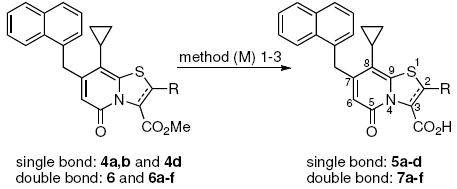 | |||||
|---|---|---|---|---|---|
| bond C-2/C-3 | R | Ma | compd | yieldb | IC50c (μM) |
| single | H- | 1 | 5a | quant | >800d |
| single | Me- | 1 | 5b | 92 | 54 |
| single | MeO- | -e | 5c | 75e | 167 |
| single | Ph- | 1 | 5d | 95 | 22 |
| double | Me- | 2 | 7a | 85 | 90 |
| double | HO(CH3)2C- | 1 | 7b | 93 | 304 |
| double | Ph- | 2 | 7c | 85 | 11 |
| double | 4-MeO-Ph- | 2 | 7d | 90 | NAf |
| double | PhCO- | 3 | 7e | 80 | NAf |
| double | PhNHCO- | 2 | 7f | 88 | 159 |
Method 1: (i) LiOH in THF/MeOH rt, (ii) H+ Method 2: (i) KOH in THF/MeOH, microwave irradiation (MWI) 90 °C 25 min, (ii) H+ Method 3: (i) Et3N, LiBr in MeCN/H2O rt, (ii) H+.
Isolated yield.
Calculated from 16-32 data points on every concentration (Figure S1 in supporting information).
Hydrolysed directly in the methoxy addition23.
Not active.
These experiments revealed that the addition of substituents in the C-2 position of the pilicide scaffold significantly enhanced the potency of the pilicides resulting in increased inhibition of pili dependent biofilm formation. The phenyl substituted compounds 5d and 7c proved to be the best pilicides with significantly improved potency compared to their parent lead compound 5a. Also the methyl substituents proved to increase the potency. However, the influence of the spatial arrangement on activity is different between the phenyl and methyl substituents. In the phenyl case, the unsaturated 7c is more potent than the saturated counterpart 5d, whereas in the methyl case the situation is the opposite, saturated 5b is more potent than the unsaturated 7a. The remaining substituents resulted in 15-30 times lower potency, compared to the most active 7c (5c, 7f, and 7b), or were completely inactive (7d and 7e).
Based on the results with phenyl substituents, and the unsaturated analogue in particular, an additional investigation with C-2 aryl and heteroaryl substituents was performed. We decided to use the Suzuki–Miyaura cross-coupling to introduce these substituents.26 In order to implement these cross coupling reactions a bromo-substituted unsaturated ring-fused 2-pyridone 8 was desired. The synthesis of 8 had previously been accomplished by a two step process starting with oxidation of 4a, followed by lithiation and bromination.23 In order to avoid unnecessary purification and isolation of the oxidized ring-fused 2-pyridone 6, a one-pot procedure going directly from 4a to 8 by modifying the developed oxidation method was envisioned. Consequently, by adjusting the reaction conditions and treating 4a with 3 equivalents of NaH followed by 3 equivalents of BrCCl3 and finally 2 equivalents of MeOH the desired bromo derivative 8 was synthesized in 91% yield (Scheme 1).
Scheme 1.
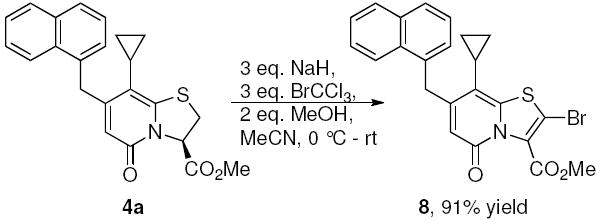
After successfully established a robust one-pot method for the key compound 8, our focus was directed to the subsequent Suzuki–Miyaura cross-coupling. For this reaction we adapted a method previously used within our lab for Suzuki–Miyaura cross-couplings.27 Interestingly, we discovered that this reaction could be performed with no use of ligands and still give the same or increased yields without influencing reaction time and temperature. Hence, seven different aryl or heteroaryl boronic acids could be coupled to give C-2 substituted thiazolo ring-fused 2-pyridones 6g-m by running the reaction at 100 °C for 10 min by microwave irradiation (MWI) with 10 mol% Pd(OAc)2, 2 equivalents of boronic acid and 1.9 equivalents of KF in dry MeOH (Table 2). The reaction resulted in good to excellent yields (72-97%, entries 1-5, Table 2) with the furane boronic acids as the only exceptions resulting in thiazolo ring-fused 2-pyridones 6l and 6m in 46% and 34% isolated yield, respectively (entries 6 and 7, Table 2).
Table 2.
Isolated yields of C-2 substituted unsaturated thiazolo ring-fused 2-pyridones.
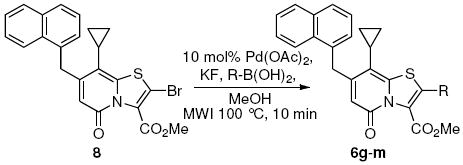 | ||
|---|---|---|
| compd | R | yield (%)a |
| 6g |  |
96 |
| 6h | 96 | |
| 6i |  |
72 |
| 6j |  |
94 |
| 6k | 90 | |
| 6l | 46 | |
| 6m | 34 | |
Isolated yield.
To expand this set of compounds, a benzyl substituted analogue 6n was synthesized in 75% yield via lithiation followed by addition of benzyl bromide using the previously described procedure.23 Before being evaluated the compounds were hydrolysed (KOH in THF/MeOH and microwave irradiation (MWI) 10-20 min at 90 °C, method 2). This rendered the corresponding carboxylic acids (7g-n) in 50-92% yield (Scheme 2).
Scheme 2.
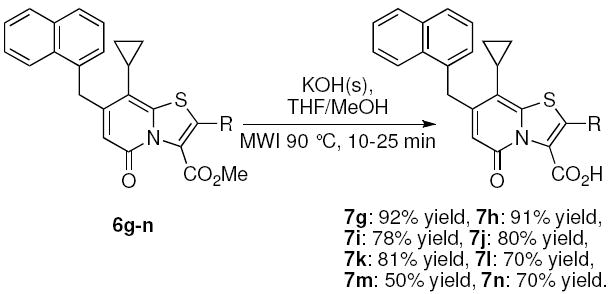
In addition to this, it has been shown that the carboxylic acid is important for a retained biological activity28 and that the use of carboxylic acid isosteres (e.g. tetrazoles or acyl sulfonamides) could lead to increased pilicide activity.29 Hence, 7c was also transformed into its corresponding methyl acyl sulfonamide 9, which had proven to be one of the most promising isosteres, in 60% yield (Scheme 3).
Scheme 3.
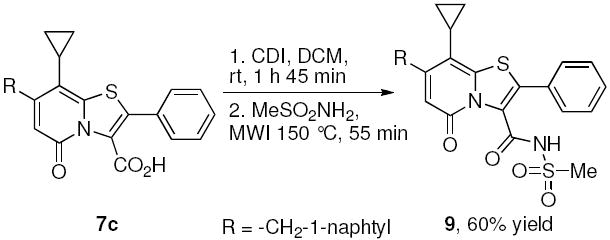
Finally, the Suzuki coupled aryl and heteroaryl compounds, the benzyl derivative, and the methyl acyl sulfonamide acid isostere were all biologically evaluated for their ability to prevent pili dependent biofilm formation (Table 3).
Table 3.
Biofilm IC50 and HA-titer data for the C-2 aryl substituted compounds 7g-n and 9.
| compd | bond C-2/C-3 | C-2 substituent | IC50 a(μM) | HA titerb |
|---|---|---|---|---|
| 5a | single | H- | >800c | 7 |
| 5d | single | Ph- | 22 | 4 |
| 7c | double | Ph- | 11 | 4.5 |
| 7g | double | 3-tolyl- | 11 | 3 |
| 7h | double | 4-tolyl- | 13 | |
| 7i | double | 5-indole- | NAd | |
| 7j | double | 6-(1,4-bensodioxane)- | NAd | |
| 7k | double | 3-thiophene- | 25 | 3.5 |
| 7l | double | 3-furane- | 78 | |
| 7m | double | 2-furane- | 61 | |
| 7n | double | Bn- | 7 | 3 |
| 9 | double | Ph- | 39 | |
| DMSOe | 8 | |||
| -f | 8 |
Calculated from 16-32 data points on every concentration (Figure S1 in supporting information).
Number of wells with agglutination (2n), E. coli was grown in the presence of pilicide (250 μM) and HA titers were determined, average of dublicate runs.
Not active.
All compounds were dissolved in DMSO.
Solely UTI89.
We found that many of the aryl and heteroaryl-substituted compounds efficiently inhibited formation of biofilm. The benzyl substituted compound 7n had an even lower IC50 than the most active compound from the first biofilm evaluation (7c) (Table 3). The tolyl substituted compounds 7g and 7h were both highly active; 3-tolyl (7g) resulted in a similar activity as the phenyl substituted analogue 7c (Table 3). Of the smaller heteroaryls, the thiophene substituted 7k proved to be more potent than the furan substituted 7l and 7m (Table 3). Sterically more demanding substituents as in 7i and 7j were not tolerated and both of them turned out to be inactive (Table 3). Interestingly, the acid isosteric acyl sulfonamide in 9 did not give any additive effect but instead gave a 3-fold decreased potency, compared to the carboxylic acid 7c (Table 3). Next, the best compounds from the biofilm evaluations were further tested using a hemagglutination (HA) assay (Table 3).14 In this assay, the degree of piliation of the culture is related to the HA titer. Thus, after growth in the presence of pilicide, the HA titers of the cultures were determined to evaluate the relative potencies of the compounds in blocking pilus formation. Growth of UTI89 in the presence of all five tested compounds resulted in significantly lower HA titers. The benzyl substituted 7n and the 3-tolyl substituted 7g resulted in 16 times increased activity compared to the hydrogen substituted compound 5a (Table 3, entry 11, 4, and 1). Interestingly, 7n, 7g and the thiophene substituted compound 7k were all more active than the phenyl substituted compounds 5d and 7c (Table 3, entry 11, 4, 8 versus 2 and 3). Importantly, the compounds did not affect the bacterial growth (Figure S2 in supporting information).
The X-ray crystal structure of pilicide 1 bound to the P pilus chaperone PapD previously revealed that the pilicide binds a conserved hydrophobic patch on the chaperone N-terminal domain, formed by residues L32, V56 and I93, that coincides with the usher binding site. Subsequently, pilicide 1 was shown to block the binding of chaperone-subunit complexes to the usher in an in vitro binding assay. Thus, we hypothesized that pilicide 1 should be capable of binding to chaperone-subunit complexes to exert its mechanism in blocking binding of the complex to the usher. This hypothesis was tested by determining the X-ray crystal structure of pilicide 1 bound to the PapD-PapH chaperone-subunit complex. Pilicide 1 was found to bind to the same global binding site as seen in the PapD-pilicide 1 structure, however, substantial reorientation was observed, possibly as a result of the conformational changes in the loop between strands F1 and G1 in the subunit-bound and free chaperone state (Figure 3, i). In the pilicide 1-PapD structure, the pilicide carboxylic acid and carbonyl group make an electrostatic interaction with R96 and R58, respectively (Figure 1, i). In the PapD-PapH bound structure, these interactions are broken. We note that in the PapD-pilicide 1 complex, the morpholine ring of 1 is in contact with a neighboring molecule, such that the effect of crystal contacts in the observed reorientation in the PapD- and PapD-PapH-bound compound cannot be excluded. Finally, to investigate the structural basis for the observed improved IC50’s after introduction of C-2 substituents, PapD-PapH crystals were soaked with the best compounds. Soaks with compound 5d generated a crystal showing the pilicide bound to the chaperone-subunit (PapD-PapH) complex at near the exact same position as the C-2 unsubstituted compound 1 (Figure 3, ii). Compared to the pilicide 1-bound form, L32 undergoes a conformational change when bound to 5d, which creates a shallow pocket that accommodates the phenyl substituent at the C2 position (Figure 3, ii & iii). The crystal structure of the N terminal domain of the FimD usher bound to the FimC-FimH158-279 16 chaperone-subunit complex is known. Modeling, based on this information, clearly shows the clash between pilicide and the usher binding site (Figure 3, iv).
Figure 3.
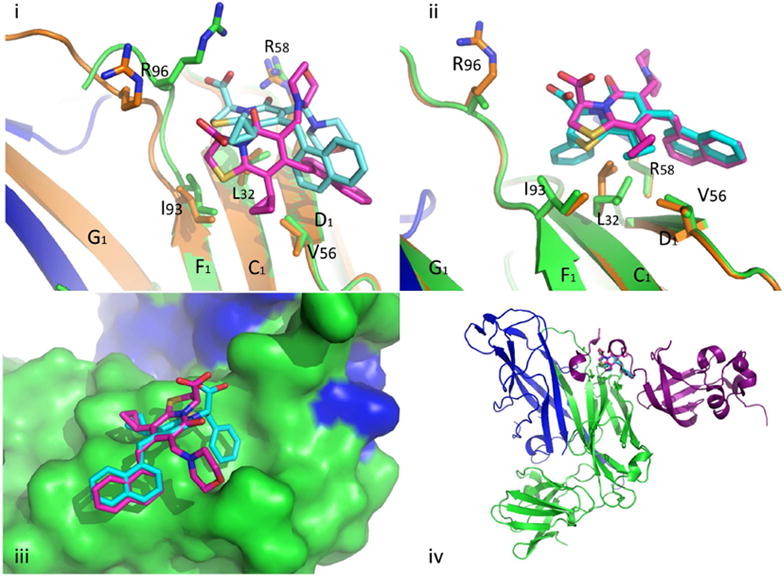
(i) pilicide 1 bound to the PapD-PapH chaperone-subunit complex (pink) undergoes a reorientation compared to pilicide 1 bound to the PapD chaperone (cyan). (ii) pilicide 5d (cyan) binds near the exact same position as C-2 unsubstitued pilicide 1 (pink) in the PapD-PapH chaperone-subunit complex. (iii) L32 reorients and thus creates a shallow pocket for the C-2 substituent in 5d (cyan). (iv) The clash between the usher FimD N-terminal (yellow) and the pilicides (cyan and pink) binding site (chaperone FimC in green and subunit FimH in blue).
Conclusion
A new route for fast and convenient synthesis of C-2 aryl substituted pilicides was developed and applied. Biofilm and HA assays revealed that proper decoration of this position significantly can improve the anti-virulence activity of the compounds. The most rewarding substituents proved to be phenyls in general and the benzyl and tolyl substituents in particular. Smaller heteroaryls (thiophene and furanes) also improved activity whereas sterically more demanding groups as indoles and 1,4-benzodioxanes abolished all activity. Combining a C-2 phenyl substituent with an acid isoster did not give any additive effect, instead a drop in activity was observed.
X ray crystallography of the pilicides bound to the PapD-PapH chaperone-subunit complex revealed that introduction of a C-2 phenyl substituent induced a reorientation of one of the chaperone (PapD) residues (L32), generating a shallow pocket that accommodates this substituent.
Experimental Section
General
Flash column chromatography (eluents given in brackets) was performed on silica gel (Matrex, 60 Å, 35-70 μm, Grace Amicon). Parallel flash chromatography was performed on a Gradmaster parallel, Jones Chromatography. 1H and 13C NMR spectra were recorded on a Bruker DRX-400 in CDCl3 [residual CHCl3 (δH 7.26 ppm) or CDCl3 (δC 77.0 ppm) as internal standard] at 298 K. IR spectra were recorded on an ATI Mattson Genesis Series FTIR spectrometer. Microwave reactions were carried out using a monomode reactor (Smith Creator, Biotage AB) in Teflon septa capped 0.5-2 ml or 2-5 ml Smith TM process vials with stirring. Reaction times refer to irradiation time at target temperature, as measured by IR sensor. Purities of key compounds were >95% as determined by 1H NMR and HPLC.
General procedure for the preparation of 6g-m
The procedure for 8-Cyclopropyl-7-naphthalen-1-ylmethyl-5-oxo-2-m-tolyl-5H-thiazolo[3,2-a]pyridine-3-carboxylic acid methyl ester (6g) is representative. Dry MeOH (0.9. ml) was added to pyridone 8 (20mg, 0.043 mmol), Pd(OAc)2 (1 mg, 0.004 mmol), KF (5 mg, 0.81 mmol) and boronic acid (12 mg, 0.085 mmol). The reaction mixture was heated in a sealed tube by microwave irradiation (MWI) at 100 °C for 10 min. The resulting mixture was diluted with CH2Cl2, washed with sat. (aq.) NaHCO3 and the aqueous layer was extracted with CH2Cl2. The combined organic layers were concentrated under reduced pressure and purification by parallel flash chromatography [heptane:EtOAc 100:0-0:100] gave pyridone 6g (20 mg, 96% yield) as yellow foam. 1H NMR (400 MHz, CDCl3) δ 0.77-0.84 (m, 2H), 1.02-1.10 (m, 2H), 1.76-1.86 (m, 1H), 2.41 (s, 3H), 3.88 (s, 3H), 4.55 (s, 2H), 5.94 (s, 1H), 7.21-7.26 (m, 2H), 7.30-7.36 (m, 1H), 7.37-7.44 (m, 3H), 7.45-7.52 (m, 2H), 7.75-7.81 (m, 1H), 7.81-7.91 (m, 2H). 13C NMR (100 MHz, CDCl3) δ 7.9 (2C), 10.9, 21.4, 36.2, 53.3, 111.7, 111.9, 123.7, 125.4, 125.5(2C), 125.7, 126.2, 127.3, 127.6, 128.6, 128.8, 128.9, 129.0, 129.1, 130.8, 131.9, 133.9, 134.2, 139.0, 146.3, 153.4, 158.9, 161.8.
General procedure for the preparation of 7a, 7c-d and 7f-n
The procedure for 8-Cyclopropyl-7-naphthalen-1-ylmethyl-5-oxo-2-m-tolyl-5H-thiazolo[3,2-a]pyridine-3-carboxylic acid (7g) is representative. KOH(s) (20 equiv) was added to 6g (17 mg, 0.0355 mmol) dissolved in THF (1 mL) and MeOH (0.5 mL). The suspension was heated by microwave irradiation for 25 min at 90 °C before being cooled to rt. The reaction mixture was diluted in CH2Cl2 and washed twice with 1M HCl. The combined organic layers were concentrated and purified by column chromatography [CH2Cl2:MeOH 97:3→CH2Cl2:MeOH 95:5 and 1% AcOH] to give 7g (15.2 mg, 92 % yield) which was lyophilized from MeCN/H2O to give a light yellow solid. 1H NMR (400 MHz, CDCl3) δ 0.68-0.75 (m, 2H), 0.94-1.03 (m, 2H), 1.66-1.76 (m, 1H), 2.32 (s, 3H), 4.45 (s, 2H), 6.12 (s, 1H), 7.02-7.09 (m, 1H), 7.14-7.18 (m, 1H), 7.20-7.25 (m, 1H), 7.27-7.38 (m, 1H), 7.37-7.41 (m, 1H), 7.41-7.50 (m, 3H), 7.70-7.80 (m, 2H), 7.82-7.88 (m, 1H). 13C NMR (100 MHz, CDCl3) δ 8.3 (2C), 11.4, 21.5, 36.7, 111.3, 113.7, 124.2, 126.0, 126.1, 126.2, 126.7, 127.9, 128.1, 128.3, 128.7, 129.26, 129.38, 129.43, 129.6, 131.1, 132.4, 134.5, 134.8, 139.4, 148.0, 154.4, 160.0, 164.5.
Structure determination of pilicide 1 and 5d bound to PapD-PapH
The PapD-PapH complex (where for PapH, residues 1-22 of the mature protein are removed for stability) was purified and crystallized as previously described.31 Complexes with pilicide 1 and 5d were formed by a 24 hour incubation of PapD-PapH crystals in the crystallization solution (10 mM cobalt chloride, 100 mM MES pH 6.5 and 1.8 M ammonium sulphate) containing 2 mM compound.
Supplementary Material
Acknowledgments
FA was supported by the Swedish Natural Research Council, the Knut and Alice Wallenberg Foundation, JC Kempe Foundation (SJCKMS), SH was supported by AI048689, AI049950, AI029549, and DK086378 grants, GW was supported by MRC grant 85602, HR is supported by a VIB Young PI project grant and the Odysseus program of the FWO-Vlaanderen.
Footnotes
Protein coordinates for the PapD:PapH:pilicide 1 and the PapD:PapH:pilicide 5d crystal complexes have been deposited with the Protein Data Bank with PDB codes 2xg4 and 2xg5 respectively.
Abbreviations: UTI, urinary tract infection; UPEC, uropathogenic E. coli; CUP, chaperone usher pathway; LDA, lithium diisopropylamide; MWI, microwave irradiation; HA, hemagglutination.
Supporting Information Available: Synthetic procedures and characterization data of all compounds, growth curves for compounds 5d, 7c, 7f and 9, details of data quality and structure refinement for structure determination of 1 and 5d bound to PapD-PapH. This material is available free of charge via the Internet at http://pubs.acs.org.
References
- 1.Boucher HW, Talbot GH, Bradley JS, Edwards JE, Gilbert D, Rice LB, Scheld M, Spellberg B, Bartlett J. Bad Bugs, No Drugs: No ESKAPE! An Update from the Infectious Diseases Society of America. Clin Infect Dis. 2009;48:1–12. doi: 10.1086/595011. [DOI] [PubMed] [Google Scholar]
- 2.Cegelski L, Marshall GR, Eldridge GR, Hultgren SJ. The biology and future prospects of antivirulence therapies. Nature Rev Microbiol. 2008;6:17–27. doi: 10.1038/nrmicro1818. [DOI] [PMC free article] [PubMed] [Google Scholar]
- 3.Clatworthy AE, Pierson E, Hung DT. Targeting virulence: a new paradigm for antimicrobial therapy. Nature Chem Biol. 2007;3:541–548. doi: 10.1038/nchembio.2007.24. [DOI] [PubMed] [Google Scholar]
- 4.Cusumano CK, Hultgren SJ. Bacterial adhesion - A source of alternate antibiotic targets. Idrugs. 2009;12:699–705. [PubMed] [Google Scholar]
- 5.Hung D, Hultgren SJ. Pilus Biogenesis via the Chaperone/Usher Pathway: An integration of Structure and Function. J Struct Biol. 1998;124:201–220. doi: 10.1006/jsbi.1998.4049. [DOI] [PubMed] [Google Scholar]
- 6.Waksman G, Hultgren SJ. Structural biology of the chaperone-usher pathway of pilus biogenesis. Nature Rev Microbiol. 2009;7:765–774. doi: 10.1038/nrmicro2220. [DOI] [PMC free article] [PubMed] [Google Scholar]
- 7.Hung DL, Knight SD, Woods RM, Pinkner JS, Hultgren SJ. Molecular basis of two subfamilies of immunoglobulin-like chaperones. EMBO J. 1996;15:3792–3805. [PMC free article] [PubMed] [Google Scholar]
- 8.Sauer FG, Remaut H, Hultgren SJ, Waksman G. Fiber assembly by the chaperone-usher pathway. Biochim Biophys Acta. 2004;1694:259–267. doi: 10.1016/j.bbamcr.2004.02.010. [DOI] [PubMed] [Google Scholar]
- 9.Bann JG, Pinkner JS, Frieden C, Hultgren SJ. Catalysis of protein folding by chaperones in pathogenic bacteria. Proc Natl Acad Sci USA. 2004;101:17389–17393. doi: 10.1073/pnas.0408072101. [DOI] [PMC free article] [PubMed] [Google Scholar]
- 10.Sauer FG, Pinkner JS, Waksman G, Hultgren SJ. Chaperone priming of pilus subunits facilitates a topological transition that drives fiber formation. Cell. 2002;111:543–551. doi: 10.1016/s0092-8674(02)01050-4. [DOI] [PubMed] [Google Scholar]
- 11.Vetsch M, Puorger C, Spirig T, Grauschopf U, Weber-Ban EU, Glockshuber R. Pilus chaperones represent a new type of protein-folding catalyst. Nature. 2004;431:329–332. doi: 10.1038/nature02891. [DOI] [PubMed] [Google Scholar]
- 12.Remaut H, Tang C, Henderson NS, Pinkner JS, Wang T, Hultgren SJ, Thanassi DG, Waksman G, Li HL. Fiber formation across the bacterial outer membrane by the chaperone/usher pathway. Cell. 2008;133:640–652. doi: 10.1016/j.cell.2008.03.033. [DOI] [PMC free article] [PubMed] [Google Scholar]
- 13.Dodson KW, Jacobdubuisson F, Striker RT, Hultgren SJ. Outer-Membrane PapC Molecular Usher Discriminately Recognizes Periplasmic Chaperone Pilus Subunit Complexes. Proc Natl Acad Sci USA. 1993;90:3670–3674. doi: 10.1073/pnas.90.8.3670. [DOI] [PMC free article] [PubMed] [Google Scholar]
- 14.Pinkner JS, Remaut H, Buelens F, Miller E, Åberg V, Pemberton N, Hedenström M, Larsson A, Seed P, Waksman G, Hultgren SJ, Almqvist F. Rationally designed small compounds inhibit pilus biogenesis in uropathogenic bacteria. Proc Natl Acad Sci USA. 2006;103:17897–17902. doi: 10.1073/pnas.0606795103. [DOI] [PMC free article] [PubMed] [Google Scholar]
- 15.Aberg V, Almqvist F. Pilicides-small molecules targeting bacterial virulence. Org Biomol Chem. 2007;5:1827–1834. doi: 10.1039/b702397a. [DOI] [PubMed] [Google Scholar]
- 16.Nishiyama M, Horst R, Eidam O, Herrmann T, Ignatov O, Vetsch M, Bettendorff P, Jelesarov I, Grutter MG, Wuthrich K, Glockshuber R, Capitani G. Structural basis of chaperone-subunit complex recognition by the type 1 pilus assembly platform FimD. EMBO J. 2005;24:2075–2086. doi: 10.1038/sj.emboj.7600693. [DOI] [PMC free article] [PubMed] [Google Scholar]
- 17.Aberg V, Fallman E, Axner O, Uhlin BE, Hultgren SJ, Almqvist F. Pilicides regulate pili expression in E-coli without affecting the functional properties of the pilus rod. Mol BioSyst. 2007;3:214–218. doi: 10.1039/b613441f. [DOI] [PubMed] [Google Scholar]
- 18.Emtenäs H, Alderin L, Almqvist F. An enantioselective ketene-imine cycloaddition method for synthesis of substituted ring-fused 2-pyridinones. J Org Chem. 2001;66:6756–6761. doi: 10.1021/jo015794u. [DOI] [PubMed] [Google Scholar]
- 19.Chorell E, Edvinsson S, Almqvist F. Improved procedure for the enantioselective synthesis of dihydrooxazolo and dihydrothiazolo ring-fused 2-pyridones. Terahedron Lett. 2010 doi: 10.1016/j.tetlet.2010.02.162. In press. [DOI] [Google Scholar]
- 20.Aberg V, Sellstedt M, Hedenstrom M, Pinkner JS, Hultgren SJ, Almqvist F. Design, synthesis and evaluation of peptidomimetics based on substituted bicyclic 2-pyridones - Targeting virulence of uropathogenic E-coli. Bioorg Med Chem. 2006;14:7563–7581. doi: 10.1016/j.bmc.2006.07.017. [DOI] [PubMed] [Google Scholar]
- 21.Pemberton N, Aberg V, Almstedt T, Westermark A, Almqvist F. Microwave-assisted synthesis of highly substituted aminomethylated 2-pyridones. J Org Chem. 2004;69:7830–7835. doi: 10.1021/jo048554y. [DOI] [PubMed] [Google Scholar]
- 22.Pemberton N, Pinkner JS, Jones JM, Jakobsson L, Hultgren SJ, Almqvist F. Functionalization of bicyclic 2-pyridones targeting piles biogenesis in uropathogenic Escherichia coli. Tetrahedron Lett. 2007;48:4543–4546. [Google Scholar]
- 23.Chorell E, Das P, Almqvist F. Diverse functionalization of thiazolo ring-fused 2-pyridones. J Org Chem. 2007;72:4917–4924. doi: 10.1021/jo0704053. [DOI] [PubMed] [Google Scholar]
- 24.Baga M, Norgren M, Normark S. Biogenesis of Escherichia-coli Pap pili - PapH, a minor pilin subunit involved in cell anchoring and length modulation. Cell. 1987;49:241–251. doi: 10.1016/0092-8674(87)90565-4. [DOI] [PubMed] [Google Scholar]
- 25.O’Toole GA, Kolter R. Initiation of biofilm formation in Pseudomonas fluorescens WCS365 proceeds via multiple, convergent signalling pathways: a genetic analysis. Mol Microbiol. 1998;28:449–461. doi: 10.1046/j.1365-2958.1998.00797.x. [DOI] [PubMed] [Google Scholar]
- 26.Miyaura N, Suzuki A. Palladium-catalyzed cross-coupling reactions of organoboron compounds. Chem Rev. 1995;95:2457–2483. [Google Scholar]
- 27.Sellstedt M, Almqvist F. Synthesis of a novel tricyclic peptidomimetic scaffold. Org Lett. 2008;10:4005–4007. doi: 10.1021/ol801506y. [DOI] [PubMed] [Google Scholar]
- 28.Aberg V, Hedenstrom M, Pinkner JS, Hultgren SJ, Almqvist F. C-Terminal properties are important for ring-fused 2-pyridones that interfere with the chaperone function in uropathogenic E. coli. Org Biomol Chem. 2005;3:3886–92. doi: 10.1039/b509376g. [DOI] [PubMed] [Google Scholar]
- 29.Aberg V, Das P, Chorell E, Hedenstrom M, Pinkner JS, Hultgren SJ, Almqvist F. Carboxylic acid isosteres improve the activity of ring-fused 2-pyridones that inhibit pilus biogenesis in E-coli. Bioorg Med Chem Lett. 2008;18:3536–3540. doi: 10.1016/j.bmcl.2008.05.020. [DOI] [PMC free article] [PubMed] [Google Scholar]
- 30.Mattsson S, Dahlstrom M, Karlsson S. A mild hydrolysis of esters mediated by lithium salts. Tetrahedron Lett. 2007;48:2497–2499. [Google Scholar]
- 31.Verger D, Miller E, Remaut H, Waksman G, Hultgren S. Molecular mechanism of P pilus termination in uropathogenic Escherichia coli. EMBO Rep. 2006;7:1228–1232. doi: 10.1038/sj.embor.7400833. [DOI] [PMC free article] [PubMed] [Google Scholar]
Associated Data
This section collects any data citations, data availability statements, or supplementary materials included in this article.


